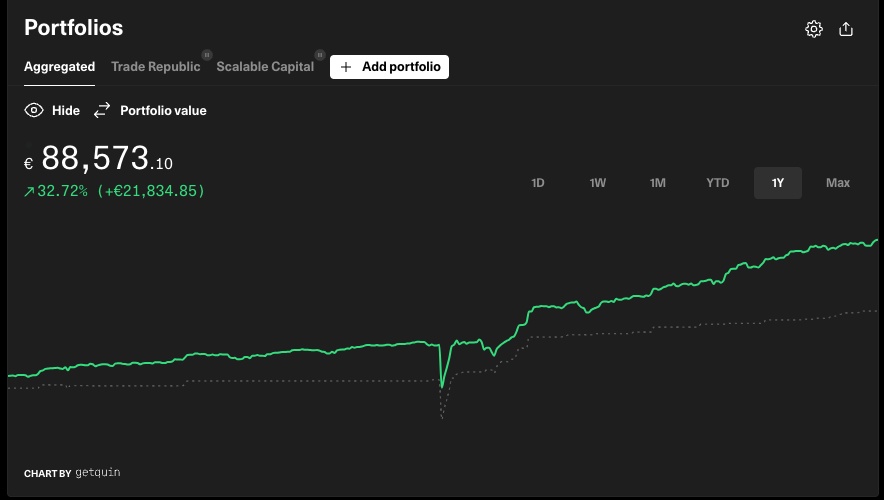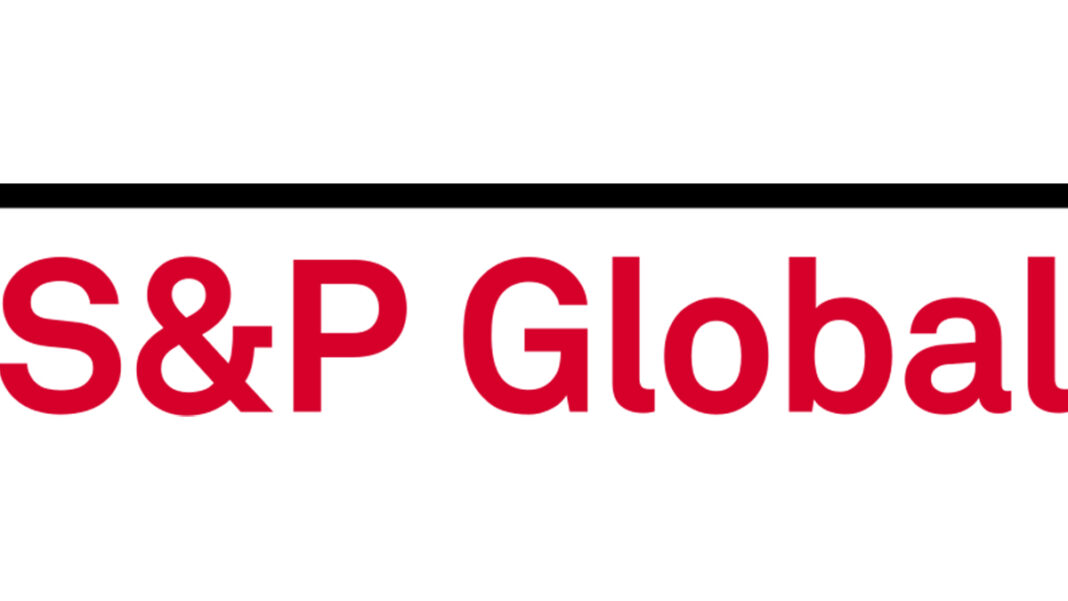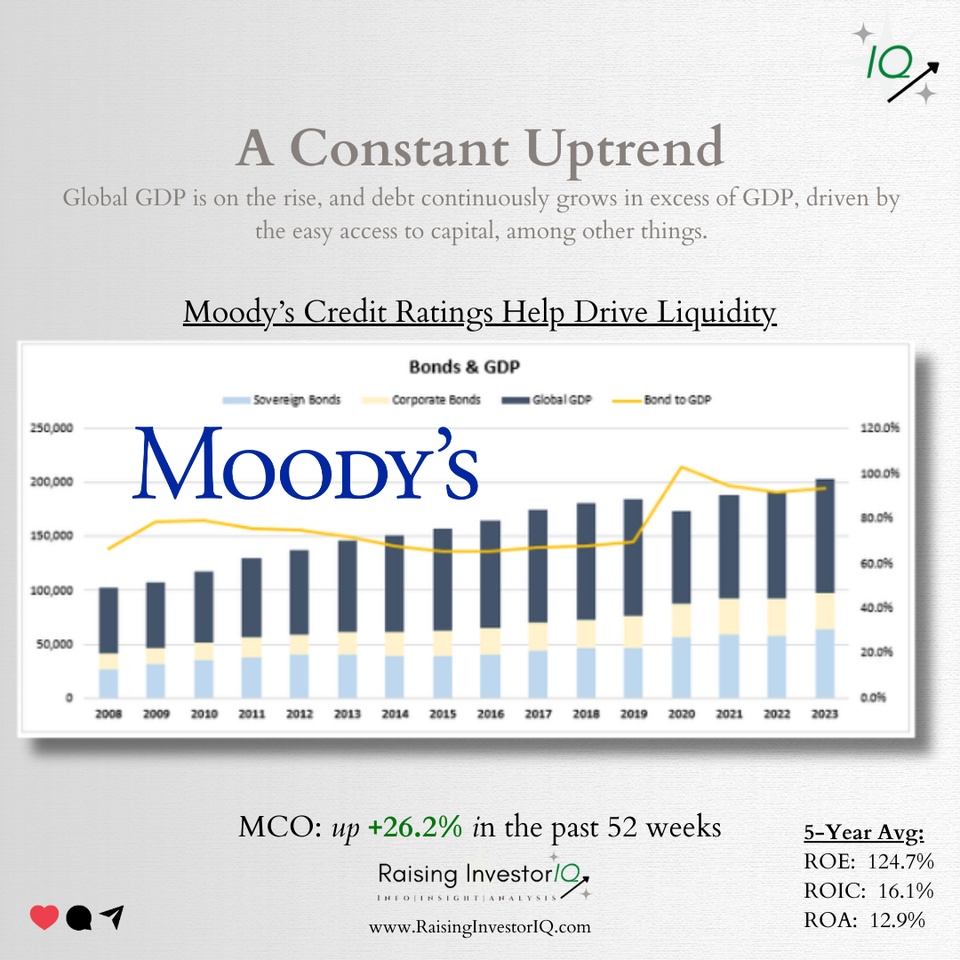In the long term, $MCO (+0,31 %) 's should continue to drive double-digit earnings growth, making even a fair valuation a compelling entry point.

Moody's
Price
Discussion sur MCO
Postes
16Portfolio at the end of 2024
In 2024, a lot has happened for me financially. I started investing around the middle of 2021. As I come from a family in which investing in the stock market was rather frowned upon (my parents invested in car manufacturers in 2000, which then slipped in 2001 just like everything else and they realized the losses), I only dared to start with small amounts bit by bit on an ETF basis in 2021. Financial flow classic 70% MSCI World ETF and 30% MSCI EM. The good thing about this was above all building up the automatism of investing money steadily and not waiting until the end of the month.
However, in 2024 I started to look more closely at the topic of finance, sometimes watching Berkshire conferences with Warren Buffett and Charlie Munger and realized that I was interested in individual stocks and would like to own Apple (shares) myself, for example. In February 24' I then looked at my EM position and saw that the position had been more or less at 0 since '21. So I sold just under €1000 and put it into Apple. And no, I didn't calculate the intrinsic value of the share first and didn't know at the time that Apple would be launching devices with AI at the end of 2024. I myself work in the field of software engineering/data science and if someone has the choice, you actually always take the Macbook over Windows computers. But that's another topic for debate :)
The Apple shares then performed really well even after the purchase and I was fascinated by the fact that I generated more unrealized profits with a single share or 6 Apple shares within 2 months than with the EM in 4 years. (I'll come back to EM later)
From March onwards, I suspended my savings plan in the ETFs and simply put the money in my Scalable clearing account instead. I didn't know what exactly I wanted to buy now, so pretty much from mid-24' I started to dive more into investing and how to analyze stocks. I had already studied discounted cash flow analysis in my bachelor's degree, back then in the subject of finance with a 3.0 :D. So I built an Excel spreadsheet and started using DCF models to calculate the intrinsic value of shares.
But what exactly should my strategy be when buying shares?
I mean, I already liked getting a dividend from Apple, so did I want to pursue some kind of dividend growth strategy? Should I go for "fast growers" as Peter Lynch would say? But should I then also add so-called "stalwarts" (dividend stocks) and "asset plays" (stocks with very expensive inventories, for example, or investments and cash whose book value is well below their actual value) to my portfolio, as he advises?
"Only buy something that you'd be perfectly happy to hold if the market shut down for ten years" - W. Buffett
Long-term focus
My investment horizon is over 10 years, so it is important to me to have some kind of predictability of income from the companies I want to buy. It was also important for me to be patient when buying from the outset and to allow some time to pass in order to check whether an investment thesis holds up over quarters.
Quality
I focus exclusively on companies with a leading position in their respective industry, either number 1 or number 2 in the respective sector with a large market share. The important thing here is that growth should be primarily organic. This means that the company should either simply build good, irreplaceable products that customers love and therefore remain loyal to, or simply be so influential that they can simply raise their prices without really losing customers ("pricing power" like Apple)
Concentration
Especially for someone coming from the financial flow school where the more diversified the investment, the better, it was hard to get used to this element. The investor Dev Kantesaria, who has successfully managed Valley Forge Capital for years and whose philosophy is also based on mine, once described this very aptly in an interview: "Why should I invest in my 25th best investment idea?". Accordingly, my goal is only to invest in a maximum of 15 individual stocks - I can't even manage to regularly check more in my free time and check whether the investment thesis still holds up.
Discipline
With the Emerging Markets ETF, I have held a position in my portfolio for several years purely out of conviction that this investment in emerging markets will work out in the long term. I also want to hold my stocks with the same conviction that they will perform well over the long term. In addition, I usually invest in companies when their intrinsic value suggests a margin of safety of at least 15-20%. For example, there was a slump in Alphabet shares in the summer with the unrest that Alphabet might be split up. The share was worth around €150 at the time. All of Alphabet's individual businesses have a combined intrinsic value of €250-300. Also related to this strategy element is that I don't really touch individual sectors that are associated with large research and development costs, for example, unless I really know my way around them. So I avoid biotech companies because I hardly know anything about them, but I invest in tech companies because I work in IT myself.
So I look for companies that are quasi monopolies in their respective industries, with strong market shares and a large moat due to irreplaceable or hard-to-penetrate products and a solid margin with a focus on steady free cash flow growth.
So why do I actually have the Emerging Markets ETF?
I asked myself this question and then promptly took another look at just ETF to see which stocks are actually in it. The top 10 holdings accounted for almost 25%. Why is that important? Some people always complain that the Magnificent 7 have such a high share in the S&P500, also slightly more than 25%, but this is usually due to the fact that companies are often weighted by market capitalization. If you then take a closer look at the top 10, 5 of them are Chinese companies. In general, China accounts for just under 25% of the ETF share. Chinese equities are not bad per se, there are some very good companies. However, the constant intervention of the government is a problem, laws can be changed overnight and a company becomes obsolete, or Mr. Ma, the CEO of Alibaba, simply disappears for a few months after having expressed mild criticism of government officials in a speech. These characteristics go against my strategy as formulated above, which is why the EM ETF was thrown out completely in July.
I then slowly tried to build up my individual positions towards the end of July, primarily $CRM (-0,88 %) , $ASML (-1,76 %) , $MSFT (-1,34 %) , $BKNG (-2,51 %) , $GOOG (+0,34 %) , $V (-0,25 %) and $AMZN (-0,99 %) . On August 5 there was a small correction, I think it was due to the "Japanese carry trade". That week I made another big purchase, very happy not to have invested all my freed-up EM capital at once. As a result, I was able to invest heavily in Amazon and Alphabet and make them my largest single positions.
Overall, I am very happy with the decision. I am aware that the last stock market year was a very good one overall and that you shouldn't be deceived by appearances. Things will probably not always go so well. My third-largest single position, in which I was in the red at just under €1500 in the meantime $ASML (-1,76 %) is good proof of this. Nevertheless, this company is a virtual monopoly in the chip manufacturing sector and will most likely remain so for the next 10 years. Therefore, I can only shrug my shoulders and look at the reports from the Magnificent 7, which are constantly expanding their data centers and in some cases were unable to meet demand in the last quarters of 2024! But there are already some good articles on this here on getquin. A new addition at the end of '24 is $UBER (+0,02 %) I will also be steadily expanding my position there, and the watchlist also includes $MELI (+0,1 %) , $MCO (+0,31 %) , $SPGI (-0,49 %) , $CAKE (-0,81 %) and $AMD (-0,7 %) for 2025.
To summarize:
Portfolio performance: 31% vs. S&P500 25%
Invested capital: approx. 22,000 euros
Portfolio value growth: approx. 42,000 euros
Goals for 2025:
- 30k invested (a large crypto cash-out will take place with approx. 20-30k, not included in the portfolio)
- Beat the S&P500
- Increase portfolio value to 150k
- Sell $TTWO (-0,4 %) (GTA 6 bet, but by the time this appears it feels like you've already done 10x in other companies)
- expansion $SPGI (-0,49 %) and addition of $MCO (+0,31 %) (credit rating duopolies)


Moody's $MCO (+0,31 %) has upgraded the outlook for Nissan $7201 (-1,74 %) to negative, although the credit rating remains unchanged. This is due to uncertainties about the company's financial recovery and the challenges in its main business areas. Moody's points to weak sales and structural problems that could jeopardize Nissan's medium-term stability.
Further details can be found in the article on TradingView.
The news is based on what I personally consider to be reputable sources. No investment advice. Follow me for more updates!
S&P Global Q3 2024 $SPGI (-0,49 %)
Financial performance:
S&P Global delivered a robust financial performance in Q3 2024 with revenue up 16% to USD 3,575 million. This growth was mainly driven by strong performances in the Ratings and Indices segments. Adjusted operating profit increased by 20% to USD 1,744 million, indicating improved operational efficiency.
Balance sheet analysis:
The balance sheet shows a stable financial position, with total assets of USD 60,368 million as of September 30, 2024. The company recorded an increase in cash and cash equivalents to USD 1,697 million, compared to USD 1,291 million at the end of 2023, indicating improved liquidity. However, there was a slight increase in current liabilities, which could indicate rising financial obligations.
Income statement:
The income statement shows a significant increase in net income, resulting in a 33% increase in GAAP diluted EPS to $3.11. In addition, adjusted diluted EPS increased 21% to $3.89 due to higher adjusted net income.
Cash flow analysis:
S&P Global's cash flow from operating activities was strong, totaling $1,445 million in the third quarter. Free cash flow improved to USD 1,330 million, indicating efficient cash management. Nevertheless, spending on financing activities increased, indicating higher outflows related to financing.
Key figures and profitability:
The company's operating profit margin improved by 530 basis points to 40.1%, while the adjusted operating profit margin increased by 180 basis points to 48.8%. These improvements underline the increased profitability and operational efficiency.
Segment analysis:
- Ratings: Sales increased by 36%, driven by strong demand for credit ratings.
- Indices: Sales grew by 18%, supported by higher asset-linked fees and exchange-traded derivatives.
- Commodity Insights: Sales increased by 9%, supported by a strong performance in the energy sector.
- Market Intelligence: Sales increased by 6%, although the adjusted margin outlook was revised downwards.
Competitive Analysis:
S&P Global continues to leverage its strong market position in credit ratings and indices. The company's strategic focus on sustainability, energy transition and generative AI positions it favorably against competitors in the evolving market environment.
Forecasts and management commentary:
The company has updated its forecast for 2024 and expects sales growth of between 11.5% and 12.5%, which represents a significant increase on the previous range of 8.0% to 10.0%. In addition, the operating profit margin is expected to expand to between 600 and 650 basis points.
Risks and opportunities:
The main risks include the potential impact of rising short-term debt and falling unrealized income, which could affect future revenue recognition. On the other hand, strategic investments in sustainability and AI offer significant opportunities for growth.
Summary and strategic implications:
S&P Global's strong financial performance and strategic initiatives indicate a stable financial position and significant growth potential. The company's focus on sustainability and AI as well as its robust revenue growth position it favorably for sustained success. Nevertheless, careful management of financial commitments and revenue recognition will be critical to maintain this growth trajectory. If you get the price right, then definitely a buy candidate alongside $MCO (+0,31 %) .
Positive statements:
- Revenue growth: S&P Global reported a 16% increase in revenue in the third quarter of 2024, reaching $3,575 million, indicating strong performance across all segments.
- Earnings per share: Adjusted diluted earnings per share increased 21% to $3.89, supported by an 18% increase in adjusted net income and a 2% reduction in diluted shares outstanding.
- Forecast adjustment: S&P Global updated its 2024 guidance to expect revenue growth between 11.5% and 12.5%, an increase from the previous range of 8.0% to 10.0%.
- Expected margin expansion: The company expects operating profit margin expansion of 600 to 650 basis points, indicating improved operating efficiency.
- Strategic focus: The strategic focus on the energy transition, sustainability and the use of generative AI is expected to expand S&P Global's data capabilities and position the company for future growth.
Negative statements:
- Revision of margin guidance: Despite the overall positive performance, the adjusted margin outlook for the Market Intelligence division has been revised downwards to 32.5% - 33.0% from 33.0% - 34.0% previously.
- Short-term debt: The company's short-term debt increased, with payments on short-term debt totaling $188 million, which could indicate increasing financial obligations.
- Financing expenses: Cash flows used in financing activities increased to $3,280 million from $2,602 million in the prior year, indicating higher outflows related to financing.
- Unearned Revenue: Unearned revenue decreased from $3,461 million at the end of 2023 to $3,288 million at September 30, 2024, potentially impacting future revenue recognition.
- Management change: The change in leadership, with Martina Cheung to be appointed as the new President and CEO, brings uncertainty as the company manages this change in top management.

Q3 2024 Moody's $MCO (+0,31 %)
Financial performance:
Moody's Corporation reported a strong third quarter 2024, with revenue up 23% to $1.8 billion. Adjusted diluted EPS increased 32% to $3.21, while adjusted operating margin increased 320 basis points to 47.8%. This positive development was driven by significant growth in both segments - Moody's Investors Service (MIS) and Moody's Analytics (MA).
Balance sheet analysis:
As of September 30, 2024, Moody's reported total assets of $15.769 billion, including $2.642 billion in cash and cash equivalents. Shareholders' equity remained solid at USD 4.068 billion, underscoring the company's strong financial position.
Income statement:
The income statement shows robust growth in both sales and profitability. MIS sales increased 41%, while MA reported a 7% increase. Operating income for the quarter was $738 million, representing an operating margin of 40.7%.
Cash flow analysis:
Moody's generated operating cash flow of $2.164 billion in the first nine months of 2024, a significant year-over-year increase. Free cash flow amounted to USD 1.921 billion, supported by the strong growth in net income.
Key figures and profitability:
Adjusted operating margin for the quarter reached 47.8%, compared to 44.6% in the prior year. Full-year adjusted diluted EPS guidance was raised to a range of $11.90 to $12.10, representing year-over-year growth of approximately 21%.
Segment analysis:
- Moody's Investors Service (MIS): Posted impressive revenue growth of 41%, with transactional revenue up 70%. The adjusted operating margin of MIS was a strong 59.6%.
- Moody's Analytics (MA): Reported a 7% increase in revenue and growth in annual recurring revenue (ARR) and recurring revenue of 9% each. MA's adjusted operating margin was 30.3%.
Competitive analysis:
Moody's continues to strengthen its competitive position, particularly in the ratings business, which saw a 41% increase in revenue. The company is also expanding its capabilities in personal lending and sustainable finance, positioning itself for future growth in these areas.
Forecasts and management comments:
The company has raised its full-year MIS revenue growth guidance to the high 20% range, with adjusted operating margin of 59%-60%. For MA, guidance for ARR growth remains in the high single-digit to low double-digit range, with adjusted operating margin of 30%-31%. Management expressed optimism for future growth, supported by cyclical and structural tailwinds such as refinancing waves and increased M&A activity.
Risks and opportunities:
- Risks: Slower than expected adoption of GenAI technologies by large financial institutions and a potential decline in transactional revenue at Moody's Analytics represent risks.
- Opportunities: Expansion into the private credit and sustainable finance market offers significant potential, with assets under management in private credit potentially growing to as much as $3 trillion by 2028.
Summary and strategic implications:
Moody's delivered a record-breaking quarter with strong growth across all segments. The company's strategic focus, particularly in personal lending and sustainable finance, positions it well for future growth. Nevertheless, challenges such as the slower roll-out of GenAI and potential declines in transactional revenues need to be addressed. Overall, Moody's is well positioned to benefit from favorable market conditions and is optimistic about further growth.
I am at least trying to find a favorable entry point and hope it works out.
5 positives and 5 negatives
Positive statements:
- Moody's Corporation reported an impressive 23% increase in revenue to $1.8 billion, marking a record-breaking quarter.
- Adjusted diluted EPS rose 32% to $3.21, underscoring the company's strong profitability.
- The Moody's Investors Service (MIS) segment delivered outstanding revenue growth of 41%, with transactional revenue up 70%, significantly outpacing global issuance growth of 51%.
- Moody's Analytics (MA) reported solid growth of 9% in both ARR and recurring revenue, with the Decision Solutions line leading the way with a 12% increase in ARR.
- The company raised its full-year guidance for MIS revenue growth to the high 20% range and adjusted operating margin to 59%-60%, signaling confidence in continued strong performance.
Negative statements:
- KYC ARR growth slowed to 14% in the third quarter, down from 19% in the year-ago quarter, due to the renewal of large contracts with the government at lower rates.
- Slower growth was observed in Moody's Analytics, with some areas such as Data & Information and Research & Insights falling short of expectations.
- The forecast for adjusted diluted EPS in the fourth quarter indicates flat or slightly declining year-on-year growth, pointing to potential challenges in maintaining the pace of growth.
- Moody's Analytics reported a decline in transactional revenue driven by a double-digit decline in low-margin transactional revenue.
- The adoption of GenAI capabilities by large financial institutions has been slower than expected, impacting the growth outlook for Moody's Analytics.

Hellas Investment Community,
How do you deal with companies that convince you of their business model but run permanently?
Notable mentions:
I've been watching all these companies for some time now and I'm seeing them run away from me.
Valuation-wise they are getting more and more expensive and were already extremely expensive at the time of first contact. Every time I analyze them, I decide not to buy them only to see them gain another 20% a few months later.
How do you approach such companies? How do you value them? How do you fight your FOMO here?
Good return and best regards from Vienna
was always too expensive for me and has been on my watchlist for 2 years. In the end, I just bought it now. It has also paid off with other companies.
Number crunchers of the financial world: Moody's vs. S&P in a data duel
Company presentation
$SPGI (-0,49 %) and $MCO (+0,31 %) are the two leading rating agencies worldwide. Both companies assess the creditworthiness of companies, countries and financial products and play a decisive role on the global financial markets. Their ratings and analyses have a significant influence on the investment decisions of investors and the financing conditions of issuers.
Historical development
S&P Global
- Founded in 1860 as Poor's Publishing
- 1941 Merged with Standard Statistics to form Standard & Poor's Corporation
- Acquired by McGraw-Hill in 1966
- Since 2016, the company has operated as S&P Global, offering an expanded range of financial market data, analytics and index solutions
Moody's
- Founded in 1909 by John Moody
- Acquired by Dun & Bradstreet in 1962
- In 2000, the spin-off from Dun & Bradstreet took place and Moody's became an independent, listed company.
Business model and core competencies
- Credit ratings for companies, governments and financial products, including bonds and structured financial products.
- The sale of financial market data and analyses that are of central importance to institutional investors, banks and regulatory authorities.
- Market indices (especially at S&P), such as the world-renowned S&P 500.
Its core competence lies in the assessment of credit risks. Decades of experience, extensive databases and highly qualified analysts make both companies indispensable players on the international financial markets.
Market position and competition
S&P Global and Moody's dominate the global market for credit ratings, together with the third major rating agency, Fitch. These three companies - often referred to as the "Big Three" - control over 90% of the market.
| Aspect | S&P Global | Moody's |
|----------------|-----------------|------------------|
| Market share | approx. 40 % | approx. 35 % |
| Strengths | Leader in market indices (e.g. S&P 500) | Stronger in corporate ratings and structured products |
S&P Global enjoys an advantage through its market indices, which serve as a benchmark for many investment funds and institutional investors.
Moody's, on the other hand, has an advantage in corporate ratings, especially for large, complex financial products.
Future prospects and strategic initiatives
- The expansion of business with financial market data and analyses in order to become less dependent on the pure rating business.
- The use of artificial intelligence (AI) and machine learning to assess credit risks more precisely and efficiently.
- Expansion into emerging markets in order to benefit from the growing financial markets in these regions.
- The development of ESG ratings (environmental, social, governance), as investors are increasingly incorporating sustainable and ethical aspects into their decisions.
Total Addressable Market (TAM)
The global market for credit ratings and financial market data is growing steadily. The increasing complexity of the financial markets and the rising demand for comprehensive credit and ESG ratings are driving this growth. In addition, stricter regulatory requirements mean that more companies and financial products have to be rated. Estimates for the overall market are in the double-digit billion range, which offers plenty of scope for further growth.
Share performance
The shares of S&P Global and Moody's have performed impressively in recent years. Both benefit from stable earnings, high margins and the growing importance of financial market data. Moody TR over 5 years 142% and S&P from 109%
For the development (company figures), a better view and more, check out the free blog:https://topicswithhead.beehiiv.com/p/zahlenjongleure-der-finanzwelt-moody-s-vs-s-p-im-daten-duell
Conclusion
In a highly regulated market with only three providers and a rising trend, there are basically only winners. Therefore, the long-term trend is less decisive as long as no major screw-ups occur. However, it must be noted that S&P's numbers do not look particularly bright at the moment, especially after a very good period. It remains to be seen, because if the situation continues like this for another two years, it would be anything but positive.
For me, Moody's is a preferred choice because Moody's specializes more in data analytics and other data-driven services. While Moody's returns on capital are not as high as S&P's, they are consistent and achieve high value over the long term. That's probably why Warren Buffett remains invested; after all, you outperform the market over the long term as long as you can crack the 10% mark in returns on capital. This does not mean that S&P is bad. If you can buy both cheaply, you should go for it because the business is highly regulated and extremely interesting.

Companies that I find interesting but do not yet have in my portfolio and that have a 10-year average ROIC of over 10% and a 5-year average ROCE and ROIC of over 10%, $ANET, $MA (-0,78 %) , $VRTX (-0,52 %) , $RMS (-0,19 %) , $PGHN (-1,6 %) , $COLO B (-1,07 %) , $ACN (-1 %) , $MNST (-0,9 %)
$FICO (-2,96 %) , $MCO (+0,31 %) , $KNIN (-1,19 %) , $S&P Global, $ISRG (-2,93 %)
$III (-4,18 %) , $BKNG (-2,51 %)
$HLAG (-1,84 %) , $QCOM (-1,95 %) , $CFR (+0,08 %) and $IFX (-0,75 %) . Already blatant companies
⚠️⚠️⚠️Breaking News⚠️⚠️⚠️
ATTENTION to all who have a deposit with Trade Republic, today more than 100 savings plans will be executed with me, the real offensive starts at 15.30 and can take up to 4 hours, as there may well be "massive" "failures" and "delays" during this time, I ask you to keep calm, take a deep breath and not to bombard Trade Republic customer support with inquiries. Thank you very much 😁
As far as the Ultimate Homer "ETF" is concerned, many new stocks were added in September 😁
In since September 2
🇺🇸Chipotle $CMG (-2,32 %)
🇺🇸Costco $COST (-0,78 %)
🇺🇸Domino's Pizza's $DPZ (-1,6 %)
🇺🇸Texas Roadhouse $TXRH (-1,16 %)
🇺🇸TransDigm $TDG (-1,35 %)
Newly launched today
🇺🇸Booz Allen Hamilton Holding
$BAH (-2,73 %)
🇺🇸Blackstone $BX (-0,29 %)
🇺🇸KKR & Co
$KKR (-0,79 %)
🇺🇸Vulcan Materials
$VMC (+0 %)
🇺🇸CSX $CSX (-0,79 %)
🇺🇸Carrier Global $CARR (-0,19 %)
🇺🇸Hilton Worldwide $HLT (-1,73 %)
🇺🇸Merck & Co $MRK (-1,78 %)
🇺🇸Moodys $MCO (+0,31 %)
🇺🇸Rollins $ROL (-1,01 %)
🇺🇸Toll Brothers $TOL (-1,62 %)
🇺🇸Watsco $WSO (-1,36 %)
🇺🇸Cardinal Health $CAH (-0,93 %)
🇺🇸Colgate Palmolive $CL (-0,56 %)
🇺🇸Emerson Electric $EMR (-1,56 %)
🇺🇸Nordson $NDSN (-1,38 %)
🇬🇧BAE Systems
$BA. (-2,19 %)
🇬🇧RELX
$REL (-1,61 %)
🇬🇧Bunzl
$BNZL (-0,12 %)

New long-term position
Hello, after a long period of consideration, I have decided to sell my shares in the Digital Security ETF and would like to replace this position with shares in a company in the financial sector.
My candidates:
Nu Holdings ( $NU (+0,85 %) )
Moody's ( $MCO (+0,31 %) )
Blackstone Group( $BX (-0,29 %) )
- With $NU (+0,85 %) I would be better diversified geographically and have a nice growth company with me
- Moody's is also a nice buy & hold company with a deep moat
- Blackstone would give me a little exposure to private equity. I'm already partly in that through Mutares ( $MUX (-1,04 %) ), but Blackstone invests in larger companies/projects. So there wouldn't be too much overlap here
Which of the 3 companies do you think you would choose and why? Or would you choose a completely different one?
I already have some financials in my portfolio:
S&P Global ( $SPGI (-0,49 %) )
Visa ( $V (-0,25 %) )
Mastercard ( $MA (-0,78 %) )
Blackrock ( $BLK )
Mutares ( $MUX (-1,04 %) )
Titres populaires
Meilleurs créateurs cette semaine












